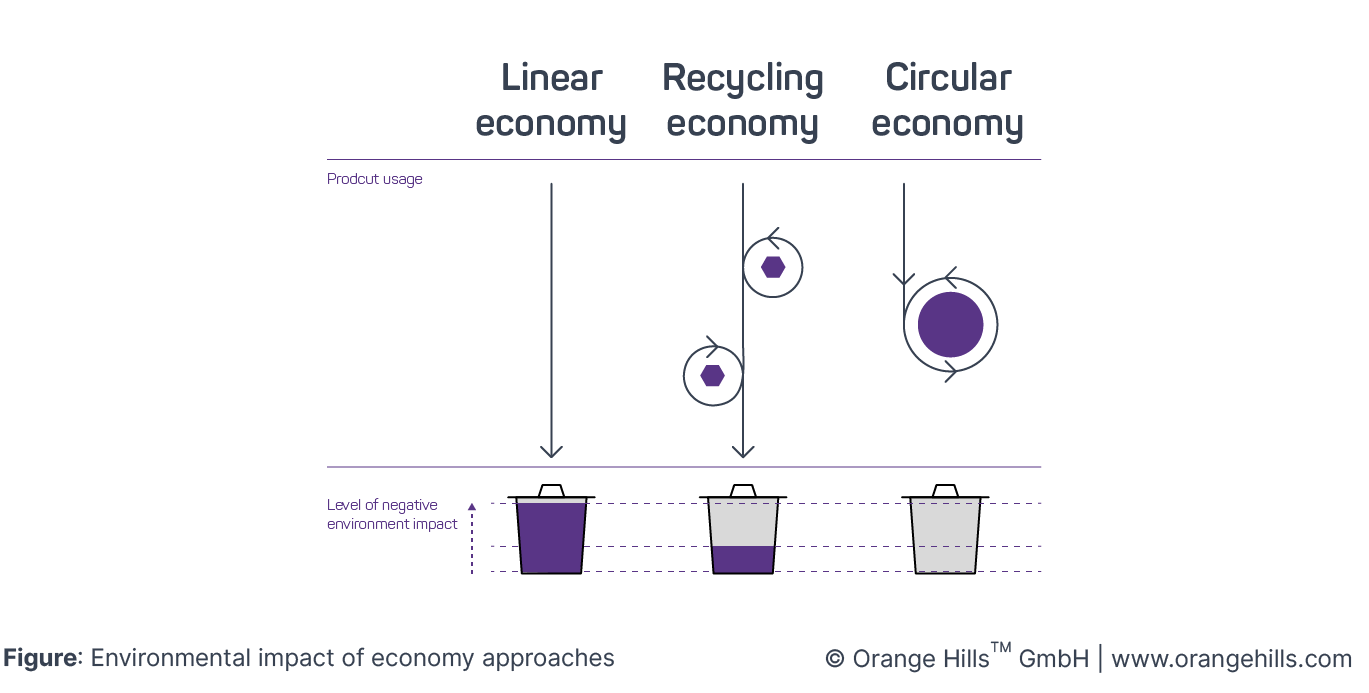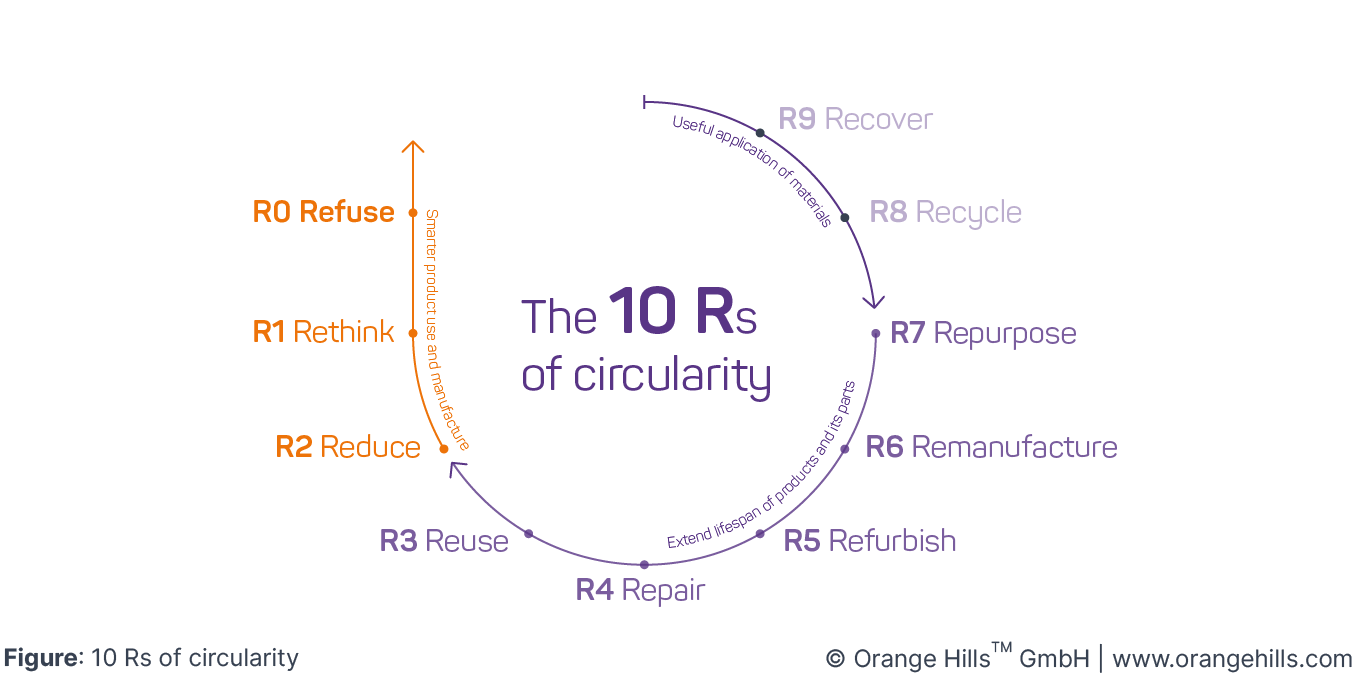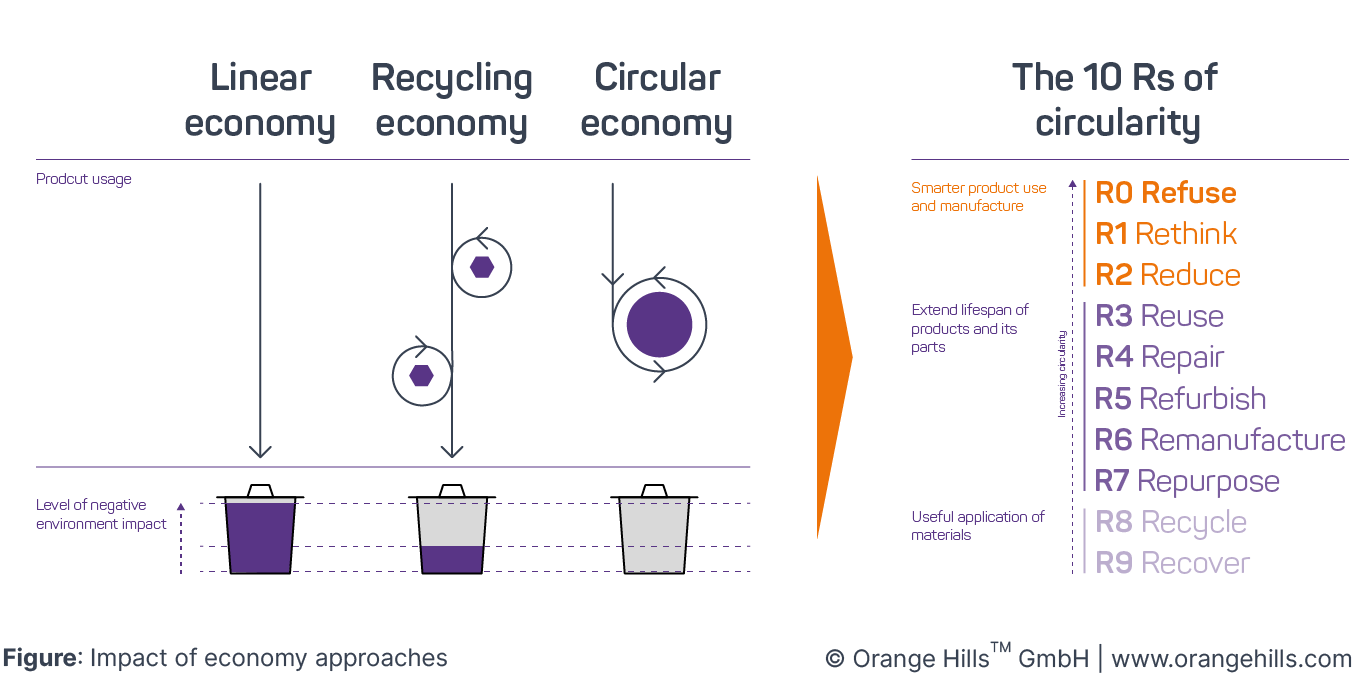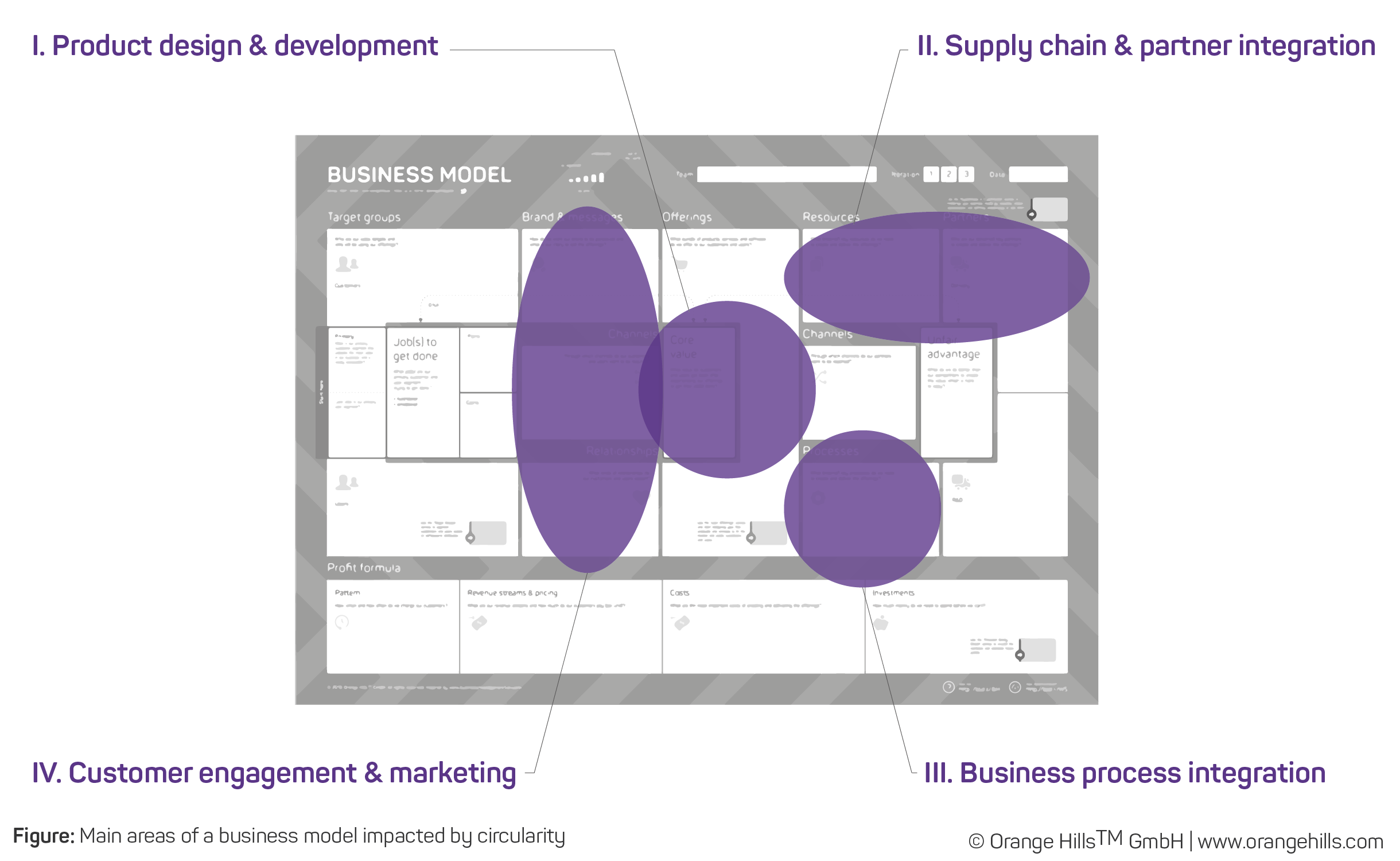Sustainable Business Model Pattern Groups
Based on our introduction of business models in action, we aim to now spotlight the specific benefits and challenges when adopting sustainable business model patterns. We have identified a range of patterns with impact to both, the ecological and social dimension, and we will discuss these patterns with a perspective on their impact to business models and a company’s operation over the coming weeks and months.

Dominik Kaiser
Sustainability Expert
Danny Locher
Business Design Coach
1. Ecological Patterns - Circular Economy Fundamentals
Circular Economy is a sustainable business model pattern that allows companies to improve the ecological footprint of their operation and at the same time creates an opportunity to establish positive economic impacts. (See Triangle of Sustainability)
1a. What is circularity and why is it crucial?
Let’s take a brief look at the theoretical underpinnings before we progress to more hands-on applications of circular business models. Circularity is one of the core elements within the ecological pillar of sustainability. Link
Resource extraction has quadrupled since 1970, highlighting a significant increase in the consumption of natural resources during this period. At the same time, our planet’s limits (as detailed in the section on planetary boundaries) cannot be extended.
Resource consumption drives climate change and biodiversity loss. Remarkably, 50% of global greenhouse gases and 90% of biodiversity and water stress are attributable to resource extraction and production.
In a traditional linear economy, the business model focuses on creating economic value through a sequence of extracting resources, manufacturing products, and disposing of them after use. This model relies heavily on continuous resource input and generates waste, contributing to environmental degradation. In contrast, a circular economy (CE) model seeks to redefine products and services by designing out waste and minimizing negative impacts on the environment. This involves incorporating reuse, repair, refurbishment, and recycling into the business operations, extending the lifecycle of products and materials.

Consequently, circular economy strategies can achieve climate goals more rapidly, cost-effectively, and with lower energy consumption.
This is where the concepts of 3, 7, or 9 Rs come into play.

The transition from a linear to a circular economy, which increases circularity, involves strategies that can be categorized into three main concepts:
Enhancing smarter use and advancing manufacture:
Implementing efficient practices in the use and production of goods to minimize waste and energy use.Extending lifespan:
Designing products for durability, reparability, and longevity to reduce the need for frequent replacements.Applying use of materials:
Optimizing material selection and utilization to ensure resources are renewable, recyclable, or biodegradable, thereby minimizing environmental impact.

1b. Benefits of circularity?
Transitioning a company’s business model to adopt circularity patterns is not easy as it usually requires rethinking and remodeling many aspects. But in return it yields possible benefits like:
Resource Efficiency:
By transitioning to a model that emphasizes the sustainable use of resources, companies can reduce their dependency on raw materials. This not only conserves resources but also shields companies from volatility in commodity prices and supply chain disruptions.Innovation and Competitive Advantage:
Circular business models often drive innovation by encouraging the development of new technologies and systems for product longevity, reparability, and resource efficiency. Companies that adopt such models may gain a competitive advantage by differentiating themselves in the market with sustainable offerings that attract environmentally conscious consumers.Regulatory Compliance and Risk Management:
With increasing global awareness of environmental issues, governments are implementing stricter regulations on resource efficiency and waste management. Companies that proactively adjust their business models to comply with these regulations can avoid legal and reputational risks associated with non-compliance.Cost Savings:
Circular economy models can lead to significant cost savings by optimizing the use of materials and energy. For instance, by designing products for easier disassembly, companies can recover valuable materials at the end of a product’s life cycle, reducing the need for new materials and decreasing production costs.Customer Relationships and Brand Image:
Companies that commit to circular economy principles can strengthen their relationships with customers and enhance their brand image. This is increasingly important as consumers and stakeholders are demanding greater environmental responsibility from businesses.Long-term Sustainability:
Finally, transitioning to a circular economy model is essential for long-term sustainability. It ensures that business growth does not come at the expense of the environment, supporting the well-being of future generations.
By rethinking their business models, companies can embrace these benefits, aligning economic success with environmental sustainability, and setting the stage for a regenerative and resilient economic system.
1c. Adopting Circular Economy Principles with Business Design
Transitioning to a circular economy represents a significant shift in how companies operate and create value. For business leaders, it is crucial to understand where and how to adapt their business models to facilitate this shift effectively.
To get an overview let us start with four key areas in business models that typically need to be adapted when companies step into circularity, along with suggested approaches for each element to get started.

I. Product design and development
“R&D accounts for 5 percent or less of the total cost of a product, it influences up to 80 percent of that product’s resource footprint” (Mc Kinsey 2022 Product sustainability: Back to the drawing board)
Adaptation needed: Products must be designed not only for use but also for a continued lifecycle, which includes reuse, repair, refurbishment, and recycling.
Suggested approach: Employ methodologies out of the Business Design E2E process, like strategic search field and ideation or Business Design sprints to innovate product designs that prioritize modularity, durability, and ease of disassembly. Involvement of engineers and designers already in the early stages of this process and in the business model development can ensure that products are created with their entire lifecycle in mind.
Working tools & methods: Business Design holds several tools and approaches that support the adaptation of an existing business model or the development of a new model working with circular patterns. Amongst them are:
Structured scoping / ideation phase to identify product design patterns and development process that support circularity
Business Design Sprints to design the business model adaptation and validate the intended positive impact to circularity
Design templates like Business Model, Service Blueprint and others
II. Supply chain and partner integration
“In 2022, the EU’s circular material use rate reached 11.5%, meaning that 11.5% of material resources used in the EU came from recycled waste materials” (Eurostat 2023 EU’s circular material use rate slightly up in 2022)
Adaptation needed: Supply chains must evolve from linear to circular, emphasizing the return and reuse of materials rather than the disposal of waste.
Suggested approach: Map the current supply chain to identify areas where resources can be looped back into the production process. Develop partnerships with suppliers and logistics companies that are aligned with circular principles. Conduct a Business Design Sprint with focus on the supply chain and partnership areas of your business model to understand what impact reverse logistics and an inflow of returned materials for reuse or recycling will have to your operation and cashflow.
Working tools & methods:
Business Design Sprints to design and validate required modifications of the business model to with from linear to circular supply chains
Design templates like Business Model, Financial Sanity Check, Service Blueprint
III. Business process integration
“Companies that integrate circular economy business models tend to innovate more rapidly, and this ability to effectively respond to changing conditions and customer needs frequently leads to better competitiveness and financial performance.” MacArthur Foundation, Towards the circular economy Vol. 1: An economic and business rationale for an accelerated transition (2013)
Adaptation needed: Business processes must be re-engineered to support circular practices such as leasing, sharing, or selling refurbished products.
Suggested approach: Utilize business model canvassing to redesign processes that incorporate circular economy principles. For instance, develop new customer service processes that facilitate product returns for refurbishing or decommissioning. Be aware about the magnitude of impacts from the re-modeling. Simple at first, service-oriented business models that focus on product-as-a-service (PaaS) where the focus shifts from selling products to leasing them would in some cases be comparable to an entire new business development.
Working tools & methods:
Business Design Sprints to design and validate required modifications of the business model from linear to circular supply chains
Design templates like Business Model, Service Blueprint
IV. Customer engagement and marketing
“There's a general willingness among consumers to adopt more sustainable practices, but there are significant gaps in actual behavior due to barriers such as insufficient market development for repair and reuse, and a lack of information about product durability and repairability." (Europen Union 2018 Behavioural Study on Consumers’ Engagement in the Circular Economy)
Adaptation needed: Shifting consumer perceptions to accept and value circular products, such as refurbished or remanufactured goods.
Suggested approach: Iterate your current product/service marketing and develop campaigns that educate consumers about the benefits of circular economy products, such as lower costs and reduced environmental impact. This, in some cases, will also require your organization to utilize new digital platforms to engage with customers directly about the lifecycle of products and the importance of their return and reuse. Other changes might include the introduction of loyalty programs into your customer relationship-part of your business model so that you can start to incentivize customers returning their products at the end of their use phase.
Working tools & methods: Business Design Sprints to iterate the current business model with focus on the marketing and customer relationship elements.
Business Design Sprints to design and validate required modifications of the business model to with from linear to circular supply chains
Design templates like Business Model, Service Blueprint
Customer segmentation templates and customer discovery approaches
Getting started
Implementing these adaptations requires a strategic approach, starting with a thorough assessment of the current business model and its impact on the environment. A Business Design Sprint provides a structured approach for an innovation team to prepare (discover-phase) the business model adaptation, design the changes (design-phase) and create insights about the impact of the changes (validate-phase) for a quick, iterative and data-driven approach into circularity.
Taking sustainability beyond mere marketing claims typically requires modifications to a company’s business model and operations. These changes, especially for companies with successful business models that have traditionally placed less emphasis on sustainability, might require substantial modifications. To de-risk these changes, Business Design and the iterative Sprint approach provide ways to apply structure, reducing uncertainties and develop a clear perspective for the path into a more sustainable and circular business operation.
